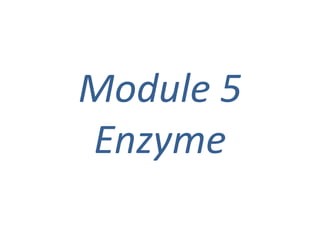
Enzyme Catalysis and Kinetics
- 2. Enzyme • An enzyme is a globular protein which acts as a biological catalyst by speeding up the rate of a chemical reaction • Enzymes are not changed or consumed by the reactions they catalyse and thus can be reused • Enzymes are typically named after the molecules they react with (called the substrate) and end with the suffix ‘-ase’ • For example, lipids are broken down by the enzyme lipase
- 3. How to monitor enzyme catalyzed reactions • Enzyme catalysis is detected by measuring either the appearance of product or disappearance of reactants. • Enzyme assays are tests developed to measure enzyme activity by measuring the change in concentration of a detectable substance. • Mass spectrometry is a rapid, sensitive, and accurate quantitative approach for the direct monitoring of enzyme-catalyzed reactions that does not require a chromophore or radiolabeling and thus provides a viable alternative to existing analytical techniques.
- 4. How does an enzyme catalyze reactions Enzyme reactions typically occur in aqueous solutions (e.g. cytoplasm, interstitial fluid, etc.) • Consequently, the substrate and enzyme are usually moving randomly within the solution (Brownian motion) • Sometimes an enzyme may be fixed in position (e.g. membrane-bound) – this serves to localise reactions to particular sites Enzyme Catalysis Enzyme catalysis requires that the substrate be brought into close physical proximity with the active site • When a substrate binds to the enzyme’s active site, an enzyme-substrate complex is formed • The enzyme catalyses the conversion of the substrate into product, creating an enzyme-product complex • The enzyme and product then dissociate – as the enzyme was not consumed, it can continue to catalyse further reactions
- 7. Mechanism of enzyme action The catalytic efficiency of enzymes is explained by two perspectives: • Thermodynamic changes • Processes at the active site
- 8. Thermodynamic Changes • All chemical reaction have energy barrier between reactant and products. • The difference in transitional state and substrate is called activational barrier.
- 11. Processes at the active site
- 12. Covalent catalysis • Enzymes form covalent linkages with substrate forming transient enzyme-substrate complex with very low activation energy. • Enzyme is released unaltered after completion of reaction.
- 13. Acid base catalysis • Mostly undertaken by oxido- reductases enzyme. • Mostly at the active site, histdine is present which act as both proton donor and proton acceptor.
- 15. Catalysis by bond strain • Mostly undertaken by lyases. • The enzyme-substrate biding causes reorientation of the structure of site due to in a strain condition. • Thus transition state is required and here bond is unstable and eventually broken. • In this way bond between substrate is broken and converted into products.
- 16. Enzyme kinetics • It is a branch of biochemistry in which we study the rate of enzyme catalyzed reactions. • Kinetics analysis reveals the numbers and order of the individual steps by which enzymes transform substrate into products. • Studying an enzymes kinetics in this way can reveal the catalytic mechanism of that enzyme, its role in metabolism, how its activity is controlled, and how a drug or an antagonist might inhibit the enzyme.
- 17. Enzyme kinetics When an enzyme is added to a substrate, the reaction that follows occurs in three stages with distinct kinetics:
- 18. Enzyme kinetics
- 19. Enzyme kinetics The pre-steady state phase is very short, as equilibrium is reached within microseconds. Therefore, if you measure the rate in the first few seconds of a reaction, you will be measuring the reaction rate in the steady state. This is the rate used in Michaelis- Menten Kinetics.
- 20. Kinetic parameters • The 'Kinetic parameters' subsection is mostly used to describe kinetic data, such as Michaelis-Menten constant (KM) and maximal velocity (Vmax).
- 21. Importance of chemical kinetic • It helps to explain how enzymes work • It helps to predict how enzymes behave in living organisms. • To understand and predict the metabolism of all living things. • Through this we know the rate of a reaction. • Kinetic parameters are used to compare enzyme activities.
- 22. RNA Catalysis • The best-characterized ribozymes are the self-splicing group I introns, RNase P, and the hammerhead ribozyme. • Most of the activities of these ribozymes are based on two fundamental reactions: transesterification and phosphodiester bond hydrolysis (cleavage). • The substrate for ribozymes is often an RNA molecule, and it may even be part of the ribozyme itself. When its substrate is RNA, an RNA catalyst can make use of base-pairing interactions to align the substrate for the reaction.
- 23. • Ribozymes vary greatly in size. A self-splicing group I intron may have more than 400 nucleotides. The hammerhead ribozyme consists of two RNA strands with only 41 nucleotides. • As with protein enzymes, the three-dimensional structure of ribozymes is important for function. • Ribozymes are inactivated by heating above their melting temperature or by addition of denaturing agents or complementary oligonucleotides, which disrupt normal base-pairing patterns. • Ribozymes can also be inactivated if essential nucleotides are changed.
